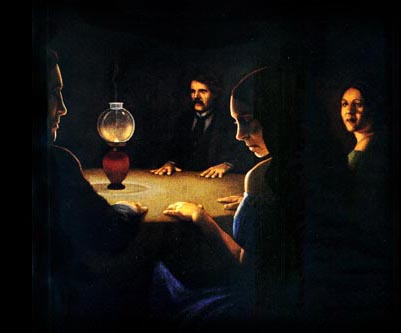 Submitted by SpectreCollector on
Submitted by SpectreCollector on

https://www.occultopedia.com/s/seance.htm
EILEEN GARRETT AND THE R-101 AIRSHIP CRASH -
One of the most dramatic and unusual events in the history of the entire Spiritualist movement occurred in October 1930.
Just two days after the huge British airship, the R101, had gone down in flames on a hillside in France --- killing 48 of its 54 passengers --- the halting voice of a man claiming to be its captain spoke through the lips of a medium in London. In short and disjointed sentences, he described his horrifying last moments before the airship burned. His account of the crash included a wealth of technical information that was not only confirmed six months later by an official inquiry but was well beyond the knowledge of the medium delivering the message. The disaster, which occurred on October 5, 1930, claimed the lives of dozens of British citizens, including two high-ranking aviation officials. It shook the government’s confidence in airships and ended the British efforts to develop these types of craft for commercial use. In short, the disaster had a devastating effect on England as a whole.
The séance at which this dramatic communication took place occurred at the National Laboratory of Psychical Research, which had been founded by Harry Price four years earlier. Price, his secretary and journalist Ian D. Coster, had arranged a sitting with a reportedly talented young medium named Eileen Garrett. The purpose of it was to try and make contact with the spirit of Sir Arthur Conan Doyle, who had recently passed away. The report of the séance was to be published in an upcoming magazine.
Eileen Garrett was born in March 1893 at Beau Park, County Meath, Ireland. She began to exhibit paranormal abilities at an early age, which did not make her family happy. They dismissed her visions and contact with the spirits as an overactive imagination. Eileen married three times. Her first marriage, to Clive Barry, produced three sons, all of whom died young, and one daughter, Eileen, who succeeded Garrett as the president of the Parapsychology Foundation, which Garrett later founded in New York.
Eileen Garrett in 1930
Following her divorce from Barry, Eileen ran a hostel for soldiers who were wounded in the Great War. Many of the men who recovered from their wounds returned to the front and Eileen often experienced precognitive visions of the men who would die there. Needless to say, this often disturbed her, which is likely why she accepted a last minute marriage proposal from one such man just before he returned to the battlefield. One month after the wedding, he was reported to be missing in action. Eileen sensed that he and several others had been killed in an explosion, which was soon confirmed. In 1918, just before the end of the war, she married J.W. Garrett, another wounded soldier. The marriage to Garrett ended in 1927 and after that, she remained single for the rest of her life.
In 1919, a frequent visitor to Garrett’s hostel began to tell her of messages that he had purportedly received through a spirit medium from his dead daughter. Although skeptical, Eileen recalled the strange experiences from her childhood and decided to listen to the man. She later accompanied him to the London Spiritualist Alliance, where she witnessed a clairvoyant during a séance. Curious, she began to attend regular meetings at the Alliance and at one of them, she experienced her first involuntary trance, during which she spoke of seeing the deceased family members of a number of sitters who were present.
The bizarre experience left her feeling both physically ill and emotionally drained. She was so upset when she came home that her husband forbid her to have anything else to do with the group. She went along with his wishes but couldn’t help but try and find out more about what had happened to her. At the suggestion of a friend, she consulted a hypnotist. During the first session, Eileen again fell into a trance, this time under the control of a spirit named Uvani. The hypnotist tried to convince her that Uvani was a spirit that was independent of her own personality but the idea was so totally opposed to Eileen’s views that she broke off work with the hypnotist with the intention of abandoning her burgeoning mediumship.
Before long though, Eileen found herself back at the London Spiritualist Alliance, where she was introduced to more advanced mediums and then got involved with Harry Price’s National Laboratory of Psychical Research. She soon began to make quite a reputation for herself as a talented medium and worked with a number of well-known researchers in the growing field. She was later tested by J.B. Rhine at Duke University and Rhine considered her to be one of the finest mediums of the day.
Eileen happened to be in southern France when war broke out again in 1939 and she stayed there until 1941, when she was able to make it to Portugal and then on to the United States. She became a U.S. citizen in 1947, established a publishing house called Creative Age Press, started a small magazine and then founded the Parapsychology Foundation in 1951. She remained a popular and respected medium throughout the 1950s and 1960s and passed away in September 1970 after a time of declining health. In addition to the history she left behind with the Parapsychology Foundation, she also published seven nonfiction books and a number of novels that she wrote under the name of Jean Lyttle.
The event that established Eileen Garrett as a medium to be reckoned with though was undeniably the séance that occurred in October 1930 with Harry Price. Shortly after the sitters gathered in the séance room, Eileen went into a trance. Instead of making contact with Conan Doyle, as they had planned, the sitters heard a voice that announced himself as Flight Lieutenant H. Carmichael Irwin. In sorrowful tones, the voice said:
I must do something about it… The whole bulk of the dirigible was entirely and absolutely too much for her engine’s capacity. Engines too heavy. It was this that made me on five occasions have to scuttle to safety. Useful lift too small. Gross lift computed badly --- inform control panel. And this idea of new elevators totally mad. Elevator jammed. Oil pipe plugged … Flying too low altitude and never could rise. Disposable lift could not be utilized. Load too great for long flight… Cruising speed bad and ship badly swinging. Severe tension on the fabric, which is chafing… Engines wrong – too heavy --- cannot rise. Never reached cruising altitude – same in trials. Too short trials. No one knew the ship properly. Weather bad for long flight. Fabric all waterlogged and ship’s nose is down. Impossible to rise. Cannot trim. Almost scraped the roofs of Achy. Kept to railway. An inquiry to be held later it will be found that the superstructure of the envelope contained no resilience and had far too much weight in envelope. The added middle section was entirely wrong… too heavy, too much over weighted for the capacity of the engines…
The reporter who took this strange and frightening communication in shorthand at first resented the intrusion of Irwin, captain of the R101, when he had expected the voice of Sir Arthur Conan Doyle. But he soon realized that he had unwittingly been part of a dramatic moment in psychical history. He published the story and it was read by, among others, a Mr. Charlton, who had been involved in the R101’s construction. Charlton asked Harry Price for a copy of the séance report. After studying it, he and his colleagues pronounced it an “amazing document”, containing more than 40 highly technical --- and highly confidential --- details of what occurred during the airship’s final flight. Charlton added: “It appeared very evident that for anyone present at the séance to have obtained this information beforehand was grotesquely absurd.”
Charlton was so impressed by the evidence that he began his own psychic investigation and ultimately became a Spiritualist. The only theory that he could put forth to explain everything that happened was that “Irwin did actually communicate with those present at the séance, after his physical death.”
Before the official inquiry into the disaster, Major Oliver Villiers of the Ministry of Civil Aviation participated in a séance with Eileen Garrett. Through the medium, he heard the voices of others who had lost their lives in the crash. The following is a portion of a conversation that took place during the séance between Villiers and a crew member, Scott, one of the victims, speaking through Eileen:
Villiers: “What was the trouble? Irwin mentioned the nose.”
Garrett: “Yes. Girder trouble and engine.”
Villiers: “I must get this right. Can you describe exactly where? We have the long struts labeled from A to G.”
Garrett: The top one is O and then A,B,C, and so on downward. Look at your drawing. It was starboard of 5C. On our second flight after we had finished we found the girder had been strained, not cracked, and this cause trouble to the cover…
Later, Villiers asked Scott if the girder had broken and gone through the airship’s covering.
Garrett: “No, not broke, but cracked badly and it split the outer cover… The bad rent in the cover on the starboard side of 5C brought about an unnatural pressure, forced us into our first dive. The second was even worse. The pressure on the gas bags was terrific, and the gusts of wind were tremendous. This external pressure, coupled with the fact that the valve was weak, blew the valve right off, and at the same time the released gas was ignited by a backfire from the engine.”
The Court of Inquiry report later showed that practically every one of these statements was correct. Not a single one of them was incorrect!
After the death of Eileen Garrett in 1970, Archie Jarman, a researcher and writer who had known her for nearly 40 years, revealed that she had asked him to “dig into the famous R101 airship case as deep as I could delve.” Jarman agreed to do so and refused to accept any fees or expenses for Eileen, so that whatever his investigation disclosed, it would be seen that he worked “without fear or favor”. He later wrote:
The completed saga, so often briefly mentioned, turned out to be a pretty massive affair. It took nearly six months and finally filled 455 pages of typescript and blueprints. It involved two trips to France, seeking the few remaining witnesses at Beauvais, where the R101 crashed. There were conferences with aeronautical experts, such as the designers of the R101’s heavy diesel engines (which were partly responsible for the fatal crash), and with the aging and active captain of the sister ship, R100.
It was the technical aspect of this case that makes it unique in psychic history ---- and I mean unique… My opinion is that greater credulity is demanded to believe that Eileen obtained her obscure and specialized data by mundane means than to accept that, in some paranormal manner, she had contact with the remembering psyche of the dead Captain Irwin to the moment of his incineration with his vast airship.
Eileen Garrett is still remembered today as one of the greatest mediums who ever lived. And interestingly, she was one of the most “low key” mediums in Spiritualist history. No spirit forms ever manifested in her presence, no tables tipped, no rapping sounds were heard and yet, without all of this fanfare, she managed to obtain some of the greatest evidence of life after death that has ever been recorded. Many saw her work as a turning point. They dismissed séance phantoms as proof of the next world and began to see mental mediumship as genuine evidence of a life beyond this one.
Troy Taylor
- 644 reads